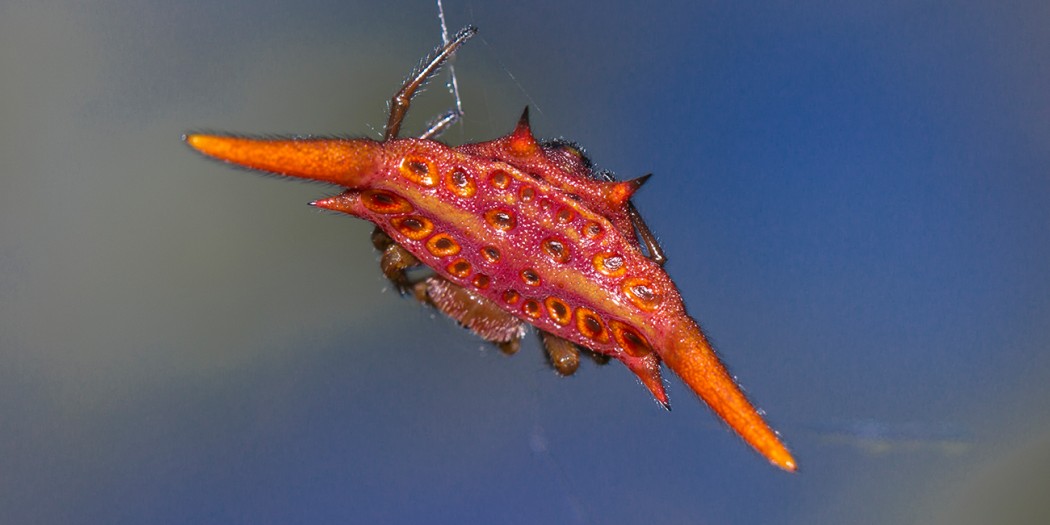Rainforests are their home: Tiny, colorful, spiny creatures in spider webs. These are spiny orb weavers, and they do not really fit into the concept of a scary, quickly moving eightlegged spider. Their unusually shaped belly part does not look scary at all. In contrast to normal spiders, they even move rather slowly and ponderously, you might almost find them cute. At least they are pretty.
Spiny orb weaver are diurnal and belong to the orb-weaver spiders. With hardly one centimeter in length, they are pretty small, but can show off their bright colors. At least the females can – male spiny orb-weaver are not spiny at all, they are inconspicuously black and only few millimeters small. Most people would not even notice them.
In Madagascar, there are five species of spiny orb-weaver: The common long-winged kite spiders (Gasteracantha versicolor) with two subspecies, avaratrae and formosa, Gasteracantha rhomboidea madagascariensis, who’s sister occurs on the Comores, Gasteracantha thorelli from Nosy Be, the rarely seen Gasteracantha sanguinolenta and Gasteracantha rufithorax, that stays much smaller than the other species.

All five species can be easily distinguished from each other by the females’ look: Some have bigger spines, some smaller ones or more spines, and others wear only distinct colors. By the way, spiny orb-weaver have nothing in common with crab spiders, although you will often hear local guides refer to this name when finding a Gasteracantha. But this term has simply evolved from the spiders’ way of moving, and is scientifically wrong.
Female spiny orb-weavers are always busy: Each evening, they yarn a new web. First they link three threads that make a triangle between three objects, e.g. branches. In the middle, the females spins supporting radially threads. They keep the next threads in place, that the female builds symmetrically in a circle and finish the typical web. She has her lurking spot in the center of the web, and fixes this place with some thicker threads. Males do not build a web at all. They simply hang out in the full sense of the word: They dangle on a single spinning threat somewhere in the tree, freely floating, never too far away from a female’s web.
At courtship display, males beat on the female’s web with their legs to make her notice the new arrival. If she thinks that he might make a good partner, she literally glues him into the web with her threads. What follows are several matings. Female spiny orb-weaver can become up to one year old. Males have a much shorter lifespan of few months, just until they have reached their purpose of life: Reproduction. Few days after mating, the males die (also if the female has not eaten them). Meanwhile the female builds a kind of cocoon, and places about 260 eggs inside. She then sticks the cocoon underneath a leaf close to her web.

Young spiny orb-weavers need only few weeks until they reach adulthood. Short after hatching, a high number of spiderlings disperse all around the shrubs. Everyone is for himself now. And there are many dangers threatening the spiny orb-weaver offspring: Small chameleons, skinks, plated lizards and other reptiles, even larger spider love to add some young orb-weavers to their diet.
In return, spiny orb-weaver eat everything small enough to fit into their webs: Tiny flies and moths, lice and small bugs are part of their food. If a feeder wriggles in the web, the spider runs there an bites it: That way she injects her poison, and the feeders dies. She then wraps her food into her threads and places it somewhere in her web. For humans, the poison is completely harmless.
By the way, almost all knowledge concerning spiny orb-weavers derives from mainland Africa. In Madagascar, research in these animals is still not even in its early stages – there simply isn’t any. Depending on this fact, scientists do not know how many spiny orb-weaver exist in Madagascar, whether they are threatened or what you could do to protect them. And this is despite the fact that spiny orb-weavers tend to be gentle and calm, you can even take it into your hand without defense. One more reason to busy oneself with these fascinating creatures and overcome human phobics: There are so much more small marvels of nature with eight legs waiting for us in Madagascar.
 MADAMAGAZINE Your Magazine about Madagascar
MADAMAGAZINE Your Magazine about Madagascar











